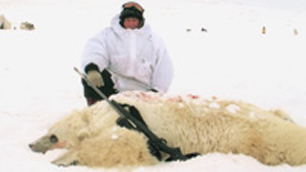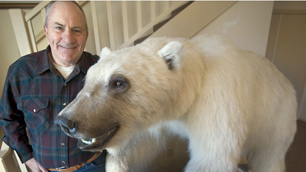
The two grizzly-polar bear hybrids discovered in Canada's North in recent years may be the tip of the iceberg, warn a trio of U.S. scientists who say the bears are a sign that Arctic biodiversity is at risk.
Pointing to other Arctic hybrids - an apparent bowhead-right whale photographed in the Bering Sea in 2009, a suspected narwhal-beluga found west of Greenland in the late 1980s, as well as various confirmed hybrid porpoises and seals - they argue governments must manage hybrids before interbreeding leads to the extinction of rare species.
In a commentary published in Wednesday's peer-reviewed journal Nature, National Oceanic and Atmospheric Administration marine biologist Brendan Kelly and his co-authors say rapidly disappearing sea ice means the barrier that once kept Arctic species apart is literally melting away.
"In addition to that, marine mammals are particularly infamous for hybridizing," says Kelly. "It turns out their genes haven't changed so much that they can't interbreed."
Co-author David Tallmon, a marine biologist with the University of Alaska, says while it's unlikely hybridization is widespread in the Arctic, no one has looked systemically at the issue. He and Kelly, along with Andrew Whiteley, a conservation geneticist at the University of Massachusetts, say the question of whether to try to stop animals from crossbreeding needs immediate attention.
"It's likely to become increasingly important as the summer ice diminishes and is ultimately lost," says Tallmon. "Hybridization is essentially impossible to reverse once it has begun on a large scale. So, we want to be sure to halt any hybridization before it becomes unmanageable and unique lineages are lost forever."
Right, but 'trying to sensationalize things'
Marco Festa-Bianchet a biologist with University of Sherbrooke, says while Tallmon and his co-authors are "basically right, they are trying to sensationalize things based on a couple of anecdotes. But the dangers are real - if unquantified."
Festa-Bianchet chaired a group of wildlife experts with the Committee on the Status of Endangered Wildlife in Canada (COSEWIC) that spent several years coming up with recommendations for Ottawa on how to deal with hybridization.
Crossbreeding of at-risk species poses particularly troubling questions. For example, should offspring of "animals of special concern" such as grizzlies and polar bears be protected? Or could that weaken genetically pure populations of disappearing animals?
Complicating matters is the fact some biologists argue hybridization is Mother Nature's answer to the rapid changes humans have made in various animals' habitats. They say it allows for a greater mix of genes within a single population of animals and acts as an insurance policy of sorts - that is, the greater an animal's genetic diversity, the more chance there is for it to adapt to a rapidly changing environment.
While Festa-Bianchet describes the issue as "god awfully complicated," COSEWIC finally released its report in April. It says that in cases where human intervention is responsible - including those due to climate change - hybrid animals and their offspring "should generally be considered a loss to the wildlife species and a threat to its persistence; hybrids do not represent either original taxonomic group, and they do not contribute to the evolutionary lineage of either group."
However, COSEWIC hedges its bets. It makes exceptions for species so rare that they are in danger of extinction, suggesting it might be a good idea to interbreed them with closely related populations to increase their chance of survival.
Hybrids made headlines in April of 2006 when an American sport hunter travelling on Banks Island, Northwest Territories, shot the first ever confirmed grizzly-polar bear. Earlier this year, another "pizzly" - the result of a female grizzly-polar hybrid mating with a male grizzly bear - was shot near Ulukhaktok, Northwest Territories.
British Columbia-based wildlife geneticist David Paetkau, whose company's DNA tests confirmed the first pizzly was born of a polar bear mother and grizzly father, said warming temperatures might have played a role. With less need for a long hibernation, the grizzly father may have had more time to wander up North. And when he could find no females of his own kind with which to mate, he chose a polar bear.
Happening elsewhere as well
But the North doesn't have a monopoly on hybridization. It's happening in other parts of the country as humans introduce species to places they didn't used to exist and break down barriers that once separated others. While animals do sometimes naturally cross-breed, hybrids resulting from human intervention are far more common.
In British Columbia, for example, extensive logging has cut down 80 per cent of the old-growth forests where spotted owls live, allowing for the invasion of barred owls. This has resulted in hybridization between the two species and threatens to wipe out the remaining tiny population of spotted owls.
In Alberta, introduced non-native trout have hybridized with the threatened cutthroat trout, contributing to an 80 per cent decline the cutthroat population.
And across eastern North America, the coyote-eastern wolf hybrid is a centuries-old example of a highly adaptable cross. The hybrids are the direct result of European settlers clearing forests for farmland in the 1800s, which destroyed much of the eastern wolf's habitat. That, and the fact settlers killed wolves because they saw them as a threat to livestock, decimated the wolf population.
At the same time, because forests no longer blocked their way, coyotes began moving east from their prairie habitat. Wolves - with few of their own kind left - began to mate with coyotes. The hybrids flourish in today's mixture of forested and cleared land because they have both the coyote's affinity for hunting in the open and the wolf's love of hunting in thick forest.

For example, the suspected narwhal-beluga cross in Greenland had teeth combining the qualities of each species but did not have a tusk, which appears to be important in attracting a narwhal mate, perhaps because it's a signal of overall fitness. No narwhal mate means fewer narwhal-like creatures, to the point where narwhal genes, and the narwhal themselves, may disappear altogether, say Kelly and his co-authors.
They also point to polar-grizzly hybrid bears in a German zoo as another example where the genetic gamble didn't work out so well. It turns out the bears are good at hunting seals, but don't have the strong swimming abilities of their polar bear forebears.
"In a first generation you retain most of the good qualities of each of your parent species ... but over time, you will break up those combinations more and more. You'll get more maladaptive combinations. So the good news [for the hybrid bear] is 'I've got these great sealing abilities, the bad news is that I really can't swim.'"



Reader Comments
to our Newsletter